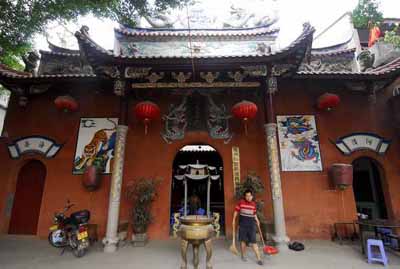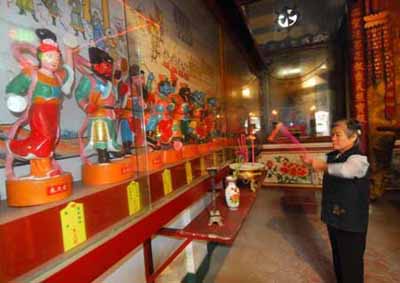"Let the holy fire burn our bodies into ashes. We followers of the Ming Jiao are charged with the responsibility of rooting out the evil and guarding the good. When there is no joy in the temporal world, we fear no pain in going to the other. Everything will turn to dust with the passing of time. It is a pity that mortal people have so much to worry about." This is a doctrine of the Ming Jiao (a Chinese version of Manichaeism) written about by Jin Yong in one of his famous martial arts novels, the Heaven Sword and Dragon Saber.
There was once a time when the Ming Jiao had a large following. In the 14th century, the Ming Jiao staged a grand uprising against the brutal ruler of the Yuan Dynasty (1206-1368). After years of struggle, Zhu Yuanzhang eventually ascended to the throne. Legend has it that to honor the Ming Jiao, he named his dynasty as Ming (1368-1644). Later, however, the newly crowned emperor found the Ming Jiao a hidden danger to his rule, so he prohibited the practice of it in the entire country, leading to the extinction of this religious sect.
Today, relics of the Ming Jiao are rarely found. In fact, until recently, the only known Ming Jiao structure remaining was a hut in Quanzhou, southeast China's Fujian Province. Therefore, it came as a great surprise when, on October 29, 2007, the Strait News reported that the Fuzhou government, also in Fujian Province, found a completely unique temple while compiling a list of historical units under city-level protection. After thorough research by a group of historians, the temple was declared to be another important relic of the long-lost Ming Jiao.
The Puxi Fushou Gong (Temple of Felicity and Longevity) is located 100 meters east of the Puxi Bridge in downtown Fuzhou. However, the inscribed board hanging over the main gate reminds visitors that the temple was once called the Ming Jiao Wenfo Zudian (Ming Jiao Buddha Temple).
In the main hall of the temple sit the Mingjiao Wenfo (Buddha of the Ming Jiao) and the Dushi Zhenren (a man who has attained enlightenment and immortality), both of whom are deities of the Ming Jiao.
On the doorframe of the main hall hang two pairs of couplets that provide modern scholars with some clues about the obscure religion. While the Ming Jiao followers kept the tradition of worshiping the sun and the moon, they had also adapted some teachings of Buddhism and Taoism.
The Puxi Fushou Gong now holds several important relics of the Ming Jiao. One is a censer made of cast iron during the reign of Emperor Qianlong of the Qing Dynasty (1644-1911). On it, words are inscribed to remind people that the censer is used specifically for worshiping the deities of the Ming Jiao.
Another important relic is a Buddha statue made in the late Qing Dynasty. Rebuilt in strict accordance with the original, the Buddha is identical to the stone statue in the Manichean Hut found in Quanzhou. Both of them have a child's face on an adult's body and their facial features are obviously alien.
Furthermore, the temple now treasures a painting from the Qing Dynasty. Although the images have faded during the past centuries, it manages to provide us a full view of the temple in the old times. In the painting, the major deities worshiped in the temple were the Mingjiao Wenfo and Dushi Zhenren. Words on the two lanterns hanging in the hall also reminded people that this temple was a shrine of the Ming Jiao.
This discovery gives historians and archeologists a profound insight into the long-lost religion originally introduced from Persia.
Gao Zhenxiong is in charge of the temple's management. He said that his great-grandfather had grown up in the temple. At that time, he said, all worshipers wore white robes and ate only vegetables during ritual days. Such practices were totally different from local customs. Gao's descriptions are echoed in a book written during the Ming Dynasty where it reports that the Ming Jiao followers all dressed in white to worship the sun in the day and the moon at night.
According to Li Linzhou, an official in charge of ethnic and religious affairs in Fuzhou, the structure, cultural relics, and special religious practices in Puxi Fushou Gong combined to prove that the temple was a former shrine of the Ming Jiao. Due to a lack of religious knowledge, local villagers remained unaware of the temple's profound background. Fortunately, during a cultural relics survey conducted recently, historians discovered the Puxi Fushou Gong was different from other commonly seen temples.
During research, the administrative committee of the Puxi Fushou Gong provided researchers with important information. According to records kept by the committee, the temple had established several branches in other locations over the past centuries. Thanks to this valuable clue, the research team managed to find another temple to the northwest of Fuzhou, where the deities of the Ming Jiao, Mingjiao Wenfo and Dushi Zhenren, were worshipped. Local villagers told the research team that the temple was founded 200 years ago by a Fuzhou merchant who converted to the Ming Jiao.
According to Li linzhou, Fuzhou was of great significance to the development of the Ming Jiao. Historical documents held that the Ming Jiao was introduced to Fuzhou during the Huichang period of the Tang Dynasty (618-907), when Empress Wu Zetian banned this religious sect nationwide. During the oppression, an eminent Ming Jiao member fled to Fujian. He first arrived in Fuqing but later settled down in Fuzhou and dedicated himself to the secret spread of Ming Jiao teachings.
Another fatal disaster was avoided during the early Ming Dynasty, when followers in Fuzhou managed to protect the temple under the cover of Taoism while all temples and documents related to the Ming Jiao were destroyed. Ming Jiao members in Fuzhou added Taoist deities into the main hall, but still worshipped the major deities of the Ming Jiao. Thanks to their wisdom and bravery, we now have the opportunity to study relics left behind by this fascinating religion.
History
The Manichaeism was founded by the Persian prophet Manes in the 3rd century. In the late 7th century, it was introduced to China. The Manichaeism advocated equality among all people and was strongly opposed to brutal rule. Most of its followers were members of the lower classes who wore white robes and worshipped light. Consumption of meat and alcohol were strictly prohibited in this sect.
The Ming Jiao played an important role in the peasants' rebellions against monarchies, especially in the nationwide uprising led by Fang La during the late Northern Song Dynasty (960-1127) and the one led by Zhu Yuanzhang during the late Yuan Dynasty.
During the early Ming Dynasty, Zhu Yuanzhang banned the Ming Jiao throughout the country, claiming that it used the same name as the dynasty and this was deemed disrespect to the imperial court. Under Zhu Yuanzhang's order, nearly all temples and documents related to the Ming Jiao were destroyed. Ming Jiao relics are therefore rarely found today.
(China.org.cn by Chen Xia, November 2, 2007)



